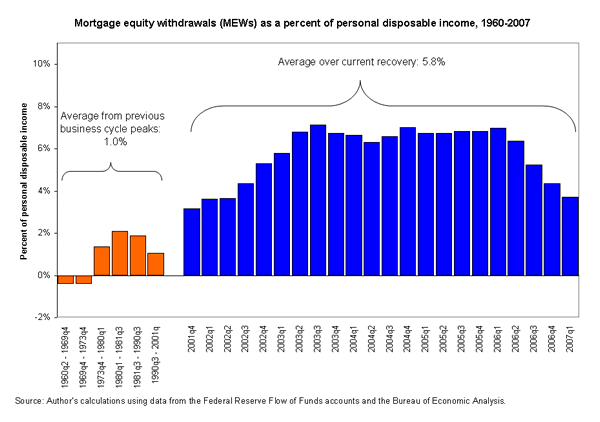See Snapshots archive.
Snapshot for July 25, 2007.
Homeowners losing purchasing power
by L. Josh Bivens
During recent Congressional testimony, Federal Reserve Chairman Ben Bernanke reassured members of the Financial Services committee about one possible channel through which the ailing housing market could harm the broader economy. Bernanke argued that the declining ability of households to boost current purchasing power through the withdrawal of home equity (a boost made possible by sharply rising home prices in recent years) would not affect spending and GDP growth going forward as home prices stabilized or even fell. On July 18, he testified:
Our sense—and this so far seems to be borne out by the data—is that consumers respond to changes in the value of their home essentially because there’s a change in their wealth, not because there’s a change in their access to liquid assets.
While this statement leaves open the possibility that households will cut back on consumption if home prices fall due to a “wealth effect,” there is reason to doubt even Bernanke’s relatively optimistic view about the link between home prices and households’ liquid assets.
The most common way for households to extract liquid assets from rising home prices is through mortgage equity withdrawals (MEWs)—taking on higher levels of mortgage debt in exchange for “cashing out” some of the accumulated equity in a house. This cashed-out equity can then be used to increase households’ purchasing power. That data provide plenty of evidence arguing that MEWs have been uniquely important in the current economic recovery.
The Chart below shows the average value of MEWs (expressed as a percentage of personal disposable income) over the course of previous economic recoveries. It also shows the quarter-by-quarter evolution of MEWs in the current recovery. The average value of MEWs in the current recovery (5.8%) is more than double the average rate in any previous recovery since 1960. Clearly, MEWs have expanded the consumption possibilities of U.S. households so far in this recovery to a much greater extent than the norm of previous recoveries.
With MEWs rapidly declining—down more than 3 percentage points since the peak in the first quarter of 2006—replacing this purchasing power should be a crucial concern going forward.

Data note: Mortgage equity withdrawal is calculated as the change in household mortgage debt (obtained from the Federal Reserve Flow of Funds data) minus residential investment in single-family dwellings (obtained from the Bureau of Economic Analysis). Because this data series is somewhat spiky, and because mortgage equity withdrawn in one quarter may not necessarily be used for household spending in that same quarter, the measure in the chart is a rolling four-quarter average of MEWs.
